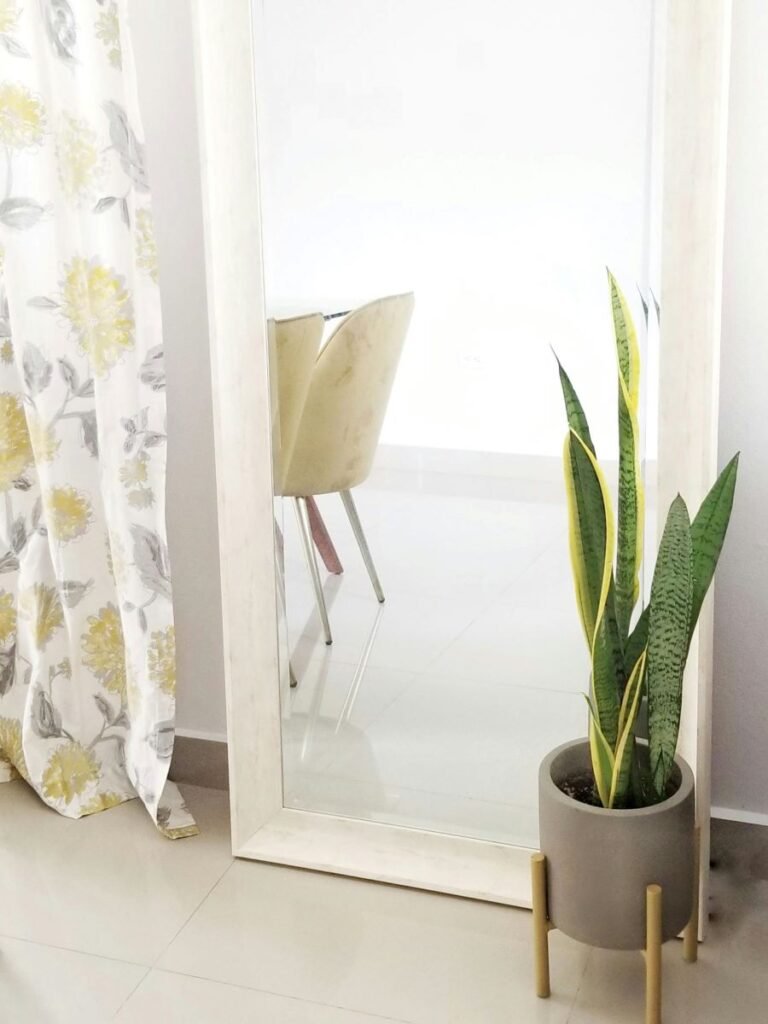Snake plants (Sansevieria spp.), also known as mother-in-law’s tongue, are among the most popular indoor plants due to their striking appearance, low maintenance, and air-purifying properties.
However, as winter approaches, caring for your snake plant requires a bit of adjustment to ensure its health and vitality.
Winter brings colder temperatures, reduced sunlight, and changes in indoor humidity, all of which can impact your plant.
In this blog, we will explore everything you need to know about snake plant winter care, offering in-depth insights and practical advice to keep your plant thriving through the colder months.

Table of Contents
Understanding the Snake Plant’s Nature
Before delving into winter care specifics, it’s essential to understand the snake plant’s natural habitat and characteristics:
- Origin: Snake plants are native to tropical and subtropical regions of West Africa. This means they are accustomed to warm climates with moderate rainfall.
- Hardiness: Snake plants are highly resilient and can survive neglect, low light, and dry conditions. They’re ideal for indoor environments.
- Growth Pattern: These plants grow slowly during winter, entering a state of dormancy. This period is crucial as their metabolic activities slow down, requiring less water and nutrients.
Challenges Snake Plants Face in Winter
Winter poses unique challenges for snake plants, which include:
- Low Temperatures: Snake plants thrive in temperatures between 60°F and 80°F (15°C to 27°C). Exposure to temperatures below 50°F (10°C) can harm the plant, causing leaf damage or root rot.
- Reduced Sunlight: With shorter days and less intense sunlight, snake plants may not receive their optimal light requirements, leading to slower growth or dull foliage.
- Overwatering Risks: The plant’s reduced water needs during dormancy make it vulnerable to overwatering, which can cause root rot.
- Dry Air: Indoor heating systems lower humidity levels, which can dry out the plant’s leaves, although snake plants are relatively tolerant of dry air.
Essential Snake Plant Winter Care Tips
1. Temperature Management
- Ideal Range: Maintain indoor temperatures between 60°F and 75°F (15°C to 24°C).
- Avoid Cold Drafts: Place your snake plant away from windows, doors, or vents where cold drafts may occur.
- Insulate Pots: If your plant is near a cold surface, such as a tile floor, consider placing a mat or stand under the pot to prevent cold damage to the roots.
2. Adjusting Light Conditions
- Maximize Natural Light: Move your snake plant to the brightest spot in your home, such as near a south- or west-facing window.
- Supplement with Grow Lights: In areas with very limited natural light, use full-spectrum LED grow lights to ensure your plant gets adequate light.
- Rotate Regularly: Turn the pot every few weeks to ensure even light exposure and balanced growth.
3. Watering Wisely
- Reduce Frequency: Water sparingly during winter, approximately once every 3-4 weeks, depending on indoor conditions.
- Check Soil Moisture: Always let the soil dry out completely before watering. Insert your finger an inch into the soil to ensure it’s dry.
- Drainage is Key: Use pots with drainage holes and avoid letting the plant sit in water. Empty the saucer after watering to prevent root rot.
4. Humidity Considerations
- Tolerant but Not Immune: Snake plants tolerate low humidity but still benefit from moderate levels (40-50%).
- Increase Humidity if Needed: If your home’s air is very dry, consider using a humidifier or placing a tray of water near the plant.
- Avoid Over-Misting: While occasional misting can help, excessive misting in low-light conditions can encourage fungal growth.
5. Fertilizing During Dormancy
- Pause Feeding: Refrain from fertilizing your snake plant during winter. The plant’s metabolic activities slow down, and additional nutrients are not required.
- Resume in Spring: Wait until late winter or early spring to resume light feeding with a balanced liquid fertilizer.
Read: Should I Fertilize My Snake Plant in the Winter?
6. Pruning and Cleaning
- Remove Dead Leaves: Trim away any yellowing or damaged leaves using clean, sharp scissors. This prevents the spread of pests or disease.
- Dust the Leaves: Wipe the leaves with a damp cloth to remove dust, ensuring the plant can photosynthesize effectively.
7. Repotting and Propagation
- Hold Off on Repotting: Avoid repotting your snake plant during winter as the plant’s growth is minimal. Spring is the best time for this task.
- Propagate Sparingly: If you wish to propagate, use leaf cuttings or rhizome division, but wait until the growing season for optimal results.
8. Pest Control
- Watch for Pests: While snake plants are relatively pest-resistant, they can attract spider mites or mealybugs in winter.
- Treat Naturally: Wipe the leaves with a mixture of water and mild soap or use neem oil to deter pests.
- Inspect Regularly: Check your plant weekly to catch infestations early.
Troubleshooting Common Winter Issues
- Yellowing Leaves: Often caused by overwatering. Check soil moisture and adjust your watering schedule.
- Brown Tips: Indicates dry air or inconsistent watering. Increase humidity or adjust watering frequency.
- Soft, Mushy Leaves: A sign of root rot. Remove the affected leaves, repot with fresh soil, and reduce watering.
- Stunted Growth: Normal during winter dormancy. Resume regular care in spring.
Preparing for Spring
As winter wanes, your snake plant will begin to emerge from dormancy. Gradually increase watering and reintroduce fertilizer to support new growth. Repot if needed, and consider propagating to expand your collection or share with friends.
Related FAQs:
Q11: Why does my snake plant look sad and droopy in winter?
Your plant might look droopy because it’s getting too much water or sitting in a cold spot. Since snake plants rest in winter, they need less water. Try letting the soil dry out between waterings. Also, move your plant away from cold windows. Most snake plants perk up when you give them warmer spots and less water.
Q12: My snake plant hasn’t grown at all this winter. Should I worry?
Not at all! Think of winter as your snake plant’s sleeping time. Just like we rest more in winter, snake plants take a break from growing. This is totally normal and healthy. Your plant is saving energy for spring when it will start growing again. Keep caring for it gently, and you’ll see new growth when warmer days return.
Q13: The soil in my snake plant’s pot stays wet forever in winter. What’s wrong?
In winter, soil takes longer to dry because there’s less sunlight and heat. Plus, your plant drinks less water during its rest time. Try using a pot with drainage holes and well-draining soil. You can also put your finger in the soil – if it feels wet an inch down, wait longer before watering again.
Q14: Can I use a heating pad under my snake plant in winter?
It’s best not to use heating pads. While snake plants like warm spots, direct heat can hurt their roots. Instead, keep your plant away from cold drafts and try to maintain a steady room temperature. If you’re worried about cold floors, put a wooden board or thick mat under the pot.
Q15: Should I mist my snake plant’s leaves in winter to help with dry air?
Actually, it’s better not to mist your snake plant, especially in winter. These tough plants don’t need extra moisture on their leaves. Too much water sitting on the leaves can lead to rot when there’s less light and air movement. If you’re worried about dry air, try running a humidifier nearby instead.
Q16: The tips of my snake plant’s leaves are getting wrinkly in winter. Help!
Wrinkly leaf tips often mean your plant is either too dry or too cold. First, check if your plant is near a cold window or door. Then, gently touch the soil. If it’s bone dry, give it a little water. Remember, while snake plants need less water in winter, they shouldn’t completely dry out.
Q17: What’s the best room in my house for my snake plant during winter?
Look for a room that stays warm and gets some natural light. Living rooms and offices often work well because they usually have stable temperatures and good windows. Just keep your plant away from heating vents, which can dry it out too much. A spot near a bright window, but not touching the cold glass, is perfect.
Q18: My snake plant’s leaves are getting dusty. Can I clean them in winter?
Yes, you can and should clean your snake plant’s leaves in winter! Dust blocks light, which is already scarce in winter. Just use a soft, damp cloth to gently wipe each leaf. Do this in the morning so any water drops can dry during the day. Clean leaves help your plant make the most of winter sunlight.
Q19: Some of my snake plant’s outer leaves are turning yellow. Should I cut them off?
Yes, you can remove yellow leaves, even in winter. Use clean scissors to cut them off near the base. Yellow leaves won’t turn green again, and removing them helps your plant look better and stay healthy. Just be careful not to remove too many leaves at once – your plant needs them for food storage during winter.
Q20: I see tiny webs on my snake plant in winter. What should I do?
Those webs might be from spider mites, which love warm, dry indoor conditions. Don’t worry – you can fix this! Mix a drop of mild soap with water, then gently wipe the leaves. Keep doing this every week until the webs are gone. This gentle cleaning also helps prevent other winter pest problems.
Remember, snake plants are tough cookies! They can handle winter with just a little extra care from you. If you’re ever unsure, it’s better to give your plant too little water than too much during the cold months. Soon enough, spring will come, and your snake plant will be ready to grow again!
Final Thoughts
Snake plants are hardy and forgiving, making them perfect companions during winter’s chill. By understanding their needs and adjusting your care routine, you can ensure your plant remains vibrant and healthy all year round.
With proper attention, your snake plant will reward you with lush, upright foliage and a sense of natural beauty that brightens even the coldest winter days.
Caring for your snake plant in winter is not just about keeping it alive but nurturing a living piece of nature in your home. Take the time to observe its needs and adapt your care—your plant (and your indoor space) will thank you!
My name is Shahriar Robin, and my journey with plants began in childhood, igniting a lifelong passion that blossomed alongside my career as a nutritionist and sports trainer. Through SnakePlant.org, I channel this dedication, merging expertise from nutrition and sports training to nurture a platform sharing all-encompassing knowledge about Snake plants. This website mirrors my commitment to cultivating greenery, offering comprehensive insights on growth, maintenance, and nurturing practices for these captivating plants. My mission is rooted in leveraging diverse expertise to enhance plant care practices, believing profoundly in the therapeutic impact of nature. Join me on SnakePlant.org, where I unite a thriving community of enthusiasts, sharing experiences, insights, and the profound joys of planting.

